
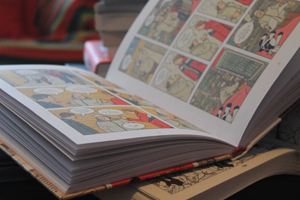
A few years ago my other half gave me
a book for Christmas. It told the story of a girl growing up through the Iranian revolution, a memoir
of one of the key events of the twentieth century. But it was written in a way I'd never seen before
in a book for adults – with pictures as well as words. The book was Persepolis, written and illustrated
by Marjane Satrapi, and since reading it I have discovered the wonderful world of graphic novels and
memoirs.

A thriving literary culture that has existed for nearly a century (the first reference to 'graphic
novels' appeared in the 1970s but the comic book industry came into being in the 1920s), graphic
novels/memoirs weave together images and texts to produce some of the most moving and interesting
books I have read. Books that are categorised as graphic novels come in many forms—comic strip
collections, fiction, non-fiction, memoirs—and, like 'standard' books they tackle a whole range
of issues from teenage angst to the daily stresses of living in a war-torn state to the joy of sex. You
might think that graphic novels are the domain of men who refuse to grow up, full of male superheroes
and pneumatically-breasted women who are secondary characters at best. While it's true that the genre
is dominated by male writers and illustrators (the Wikipedia entry for graphic novels mentions only
one woman) women have been active in the medium for many years, producing powerful, important works.
This article is a brief introduction to my discoveries so far.
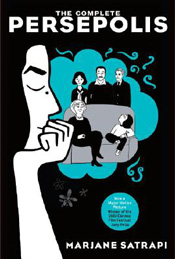
Persepolis is certainly a great example of these powerful stories. Satrapi illustrates her
life story and the changes wrought on her home country by revolution with simplistic, almost childish,
black and white pictures that belie the serious events being depicted. In one scene, for example, she
depicts the burning of a cinema, showing those locked inside the building as ghostly figures floating
away in the flames. The illustration is a harrowing expression of the horror and fear that the hundreds
of people must have felt as they realised that they were going to burn to death. It's an image that
has stayed with me for a long time.
Of course one of the joys of reading is building up an image of a character, event or place in your head
from the author's descriptions. So is that pleasure lost when reading a graphic novel or memoir? I don't
think so. The pictures actually give me more space to imagine a character's thoughts or emotions because
all I have to go on is a facial expression and a few words. And each illustrator/writer has her own unique
style that contributes to the atmosphere of the story.
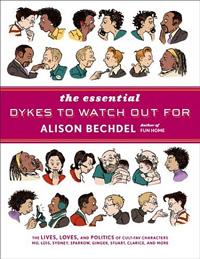 While it may seem as if Persepolis has been the catalyst for a growing body of graphic novels by
female illustrators/writers since its publication in 2000, women have been writing comics and graphic
novels for years. Finnish author Tove Jansson, for example, is probably best known for her Moomin books,
first published in 1945; Posy Simmonds, a UK illustrator, has been creating cartoons for grownups since
the 1970s.
While it may seem as if Persepolis has been the catalyst for a growing body of graphic novels by
female illustrators/writers since its publication in 2000, women have been writing comics and graphic
novels for years. Finnish author Tove Jansson, for example, is probably best known for her Moomin books,
first published in 1945; Posy Simmonds, a UK illustrator, has been creating cartoons for grownups since
the 1970s.
Similarly, American cartoonist Alison Bechdel's comic strip "Dykes to Watch Out For" has been running
since 1987. You must forgive me if I go into raptures at this stage. The Essential Dykes To Watch
Out For, a collection of strips, is one of my favourite reads of all time. The main characters are
liberal, lentil-eating lesbians. They are political, gay, loving, selfish, funny, hurtful, seriously
intelligent, sexual, sexy, annoying, bi, good parents, not so good parents, drag kings and above all
friends. Bechdel's portrayal of these women is deeply intelligent and funny and often sad as the main
characters grow from politically feisty young people into adults, with the opportunities and
responsibilities that presents. I can't believe how much I grew to love these women considering they
actually say and think in many fewer words than characters in a novel. I felt bereft when I finished
the book and would no longer share their lives. A cartoon strip is no less powerful than a prose novel.
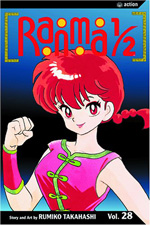
Beyond Europe and North America, Japanese women have been creating shŏjo manga, comics specifically
for women and girls, since the 1960s and there are some highly talented all-female collectives active in
the genre. CLAMP, for example, is a very successful manga artist group whose work has sold in the millions.
An article published in 2007 suggests that nearly half of Japanese women under the age of 40 read manga
regularly, a level of comic book readership that I'm sure cannot be surpassed by any other country. I've only
read one manga work so far, the first volume of Ranma ½ by Rumiko Takahashi. It's a cute, funny and
fantastical story of Ranma, a boy with a secret. After falling into a cursed pool, he turns into a girl
when he gets wet. And his dad often changes into a panda. While Ranma might be a bit childish for some
people's tastes, there are some really nice touches in both the art work and text that made me chuckle;
a martial arts venue is called the 'School of Discriminate Grappling', for example. Takahashi is one of
the most respected women writing manga, and I will be seeking out more of her work.
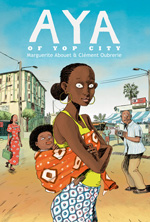
Despite these earlier examples of graphic novels written by women, however, the publication of
Persepolis a decade ago does seem to have opened up the graphic novel/memoir genre more widely to
women from across the globe both as creators and readers, or perhaps it is that publishers have caught
on to the interest in these books and are more willing to produce and promote them. Aya of Yop
City (2008), for example, is about being a teenager in 1970s Cote D'Ivoire by Marguerite Abouet. She
writes the text and her husband creates the illustrations. Abouet's Wikipedia page states that she was
inspired by Persepolis to create an African graphic novel, a story that wasn't about war or famine.
Perhaps she felt that the best way to do this was to use a different medium from to other African writers. Aya
is the only example of a graphic novel from this part of the world that I've found so far and while I
don't think it's as successful as other books I've mentioned, it is worth a read.
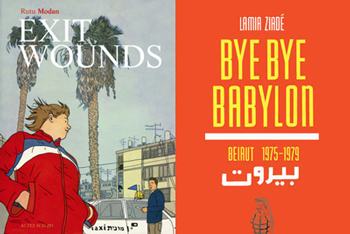 The graphic novel seems to have really caught the imagination in the Middle East (the Harvard Center for
Middle Eastern Studies seems to have a whole programme devoted
to exactly this subject). Israeli illustrator Rutu Modan's Exit Wounds (2008; reviewed
in Issue 9 of Belletrista) is a fiction work about a young man who believes his father has died
in a suicide bombing in Tel Aviv. It's another work in which there are standout images of immense
power, as is Bye Bye Babylon by Lebanese author Lamia Ziadé, which
I've reviewed in this
issue of Belletrista. And I should note that Marjane Satrapi has published more recent graphic novels
about life in Iran since Persepolis, including Chicken with Plums.
The graphic novel seems to have really caught the imagination in the Middle East (the Harvard Center for
Middle Eastern Studies seems to have a whole programme devoted
to exactly this subject). Israeli illustrator Rutu Modan's Exit Wounds (2008; reviewed
in Issue 9 of Belletrista) is a fiction work about a young man who believes his father has died
in a suicide bombing in Tel Aviv. It's another work in which there are standout images of immense
power, as is Bye Bye Babylon by Lebanese author Lamia Ziadé, which
I've reviewed in this
issue of Belletrista. And I should note that Marjane Satrapi has published more recent graphic novels
about life in Iran since Persepolis, including Chicken with Plums.
Just as I was finishing this article, the UK's Guardian newspaper published a feature about
Bayou Arcana, a horror anthology created by an all-female group of artists and all-male
group of writers. The article discusses women in the comic book world and highlights several graphic
novel authors that I haven't heard of before, including Polish author Marzena Sowa whose memoir
comic Marzi has recently been translated into English. Let's hope that this surge of interest in
female-authored graphic novels continues and brings us more wonderful stories from across the globe.
In my research I haven't come across any graphic novels by women from South America, Australia or Asia, apart from Japan. I'd love to hear from Belletrista readers who can recommend other books that I should read (graphicnovels [at] belletrista.com). Please send in your suggestions of female-authored graphic novels, old and new, and we'll publish them in the next issue.
Information sources:
Drawn and Quarterly—a Canadian publisher
producing works by a number of female illustrators/writers
Hey, Women! Comics! – a blog 'for women who'd like to
read comics but aren't sure where to start'. It hasn't been updated for a while but is a useful resource.
More information about shŏjo manga.
Guardian article about women
in the graphic novel world.

Charlotte Simpson lives in London. She reads a wide range of classic and contemporary
fiction written by women and is currently focusing on Africa. She has a Masters degree in
Modern British Women's History.